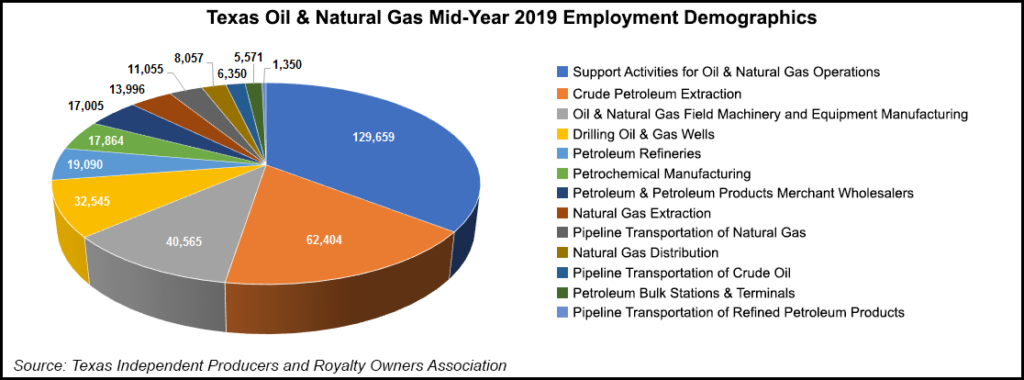E&P | NGI All News Access | NGI The Weekly Gas Market Report | Permian Basin
Texas Oil, Gas Sector Bracing for Slowdown into 2020
The Lone Star State’s oil and gas industry remains a “powerful employer” in Texas, but operators expect to see a slowdown through the rest of this year, according to a top industry group.

Through June, the Texas energy industry added nearly 10,000 new jobs versus 2018, representing a total of more than 365,000 direct jobs, the Texas Independent Producers & Royalty Owners Association (TIPRO) said in its midyear report.
TIPRO’s nearly 3,000 members produce an estimated 90% of the state’s oil and gas, and they represent a spectrum of operators, from small producers owned by families to large public independents.
“The Texas oil and gas industry remains a powerful employer in the Lone Star State, as evidenced by findings of the new mid-year TIPRO report,” said Chairman Eugene Garcia. “In the first half of the year, the Texas oil and gas industry accounted for 40% of all oil and gas jobs nationwide.”
On average, oil and gas jobs in Texas paid 134% higher wages than the private sector, with annual industry wages averaging $130,000 and a total state payroll of $47 billion, researchers noted.
Through June, Texas oil production increased by 131 million bbl compared with the first half of 2018, for a total of 882 million bbl. Natural gas production rose by 580 MMcf for a total of 4.9 Tcf.
“Oil and natural gas production in Texas is on track to break all previous production records in the state for the full year of 2019, with estimated production expected to surpass 1.7 billion bbl of oil and natural gas production potentially exceeding 10 Tcf,” TIPRO said.
Unsurprisingly, the Permian Basin was credited with driving production gains, with crude output alone accounting for nearly two-thirds of Texas output, according to the research. In mid-August, the Texas rig count represented about half of the active rigs in the United States.
Still, the rig count is falling, an important factor as the Permian’s lost rigs account for around 25% of the dropped rigs. The Gulf Coast also has dropped rigs, TIPRO noted.
“Although oil and gas production keeps climbing in Texas, the number of drilling permits issued from the Railroad Commission of Texas through the first half of 2019 has also gone down,” TIPRO noted.
“State data shows that in July the commission issued a total of 912 well permits, down from 1,001 issued in June, and from 1,153 approved last July. The number of oil, gas and injection well completions also dipped in July to 699, compared to 940 over the same time last year.”
In addition, total well completions in the state processed were 5,749 year-to-date, versus 6,514 for the same period of 2018.
TIPRO attributed slowing drilling activity to a variety of factors, including infrastructure constraints in the Permian and volatile market conditions.
“Technological advancements continue to make oil and gas operations more efficient, allowing Texas to achieve record-setting production of oil and natural gas despite a dip in drilling activity,” said TIPRO President Ed Longanecker.
Through the first six months, “operators have been successful in growing domestic energy production levels and adding new jobs while also facing a broad array of issues, including the United States’ escalating trade war against China.
“Uncertainty in the market, not necessarily supply/demand fundamentals, is contributing to the volatility with commodity prices. Unless these issues can be resolved, the United States could experience a slowdown in domestic production growth and an insufficient number of wells to offset the decline rate in the short-term.”
Texas through the first half of this year held the highest number of oil and gas businesses in the nation with 12,120 establishments, according to TIPRO. The state’s industry is also relatively young, with around one-half of the oil and natural gas workers between the ages of 25 and 44; roughly 23% were 55 years or older.
During the first half of 2019 there were 34,127 job postings for the Texas oil and natural gas industry, led by Houston (12,421), Midland (2,082), Dallas (1,401), San Antonio (1,276) and Odessa (1,145).
© 2024 Natural Gas Intelligence. All rights reserved.
ISSN © 2577-9877 | ISSN © 1532-1266 | ISSN © 2158-8023 |
